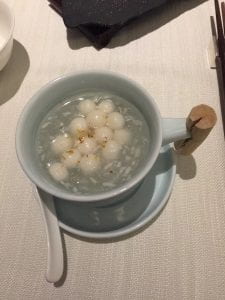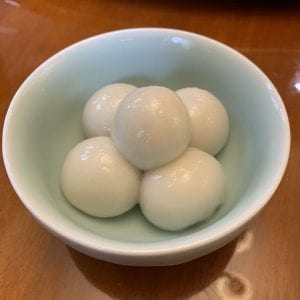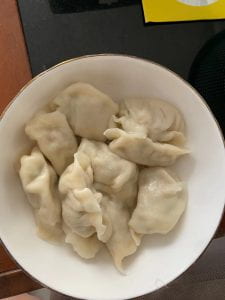General Information about Item:
- Genre: Material Lore – dish; Customary Lore – celebration, belief, superstition
- Language: English with some Chinese (Mandarin)
- Country of Origin: China
- Informant: S.G.
- Date Collected: November 23, 2020
Informant Data:
- S.G. is a 22-year-old senior studying engineering and mathematics at Vassar College and Dartmouth College’s dual degree program. He grew up in Beijing, China, and went to college in the US. His family is a traditional Beijing family, which practices many northern-China traditions.
Contextual Data:
- Cultural Context: Glutinous rice balls are eaten during the Chinese New Year mainly because of its auspicious name and shape. For many Chinese families in mainland China as well as overseas, glutinous rice balls are typically eaten together with family. The round shape of the balls and the bowls in which they are served symbolizes family cohesion. The name of Glutinous rice balls, “tāngyuán” (汤圆), is also a homophone for union, “tuányuán” (团圆).
- Social Context: During the Chinese New Year, family members gather together and glutinous rice balls often serve as a dessert at the end which is typically eaten together with the whole family.
Item:
- Glutinous rice ball is a Chinese dessert that is a ball of glutinous rice flour and water that has been either boiled and served in a hot broth or syrup or else deep-fried. Glutinous rice balls are traditionally eaten during Yuanxiao in the Lantern Festival and also serve as a dessert during the China New Year. It is pronounced “tāngyuán,” which a homophone for union “tuányuán.” Thus, the glutinous rice ball is a symbol of family reunions. It is eaten in both northern and southern China, but in different areas, people may prefer glutinous rice balls with different fillings.
Image File:

Unfilled rice balls, cooked with osmanthus and sweet fermented glutinous rice (S.G. took this photo last year during the Chines New Year when he and his parents were eating dinner at a restaurant.)

Sweet rice balls with sesame filling (S.G.’s family made this two years ago on the Chinese New Year’s day.)
Transcript of Interview Clip:
S.T. (collector): What is one of the most interesting or important dishes that is eaten during the Chinese New Year in your family?
S.G. (informant): My family likes to eat the glutinous rice ball, which is also called “yuanxiao.”
S.T.: I like it as well. What flavor of the rice balls does your family normally eat? Sweet or salty? What fillings?
S.T.: We like to eat sweet rice balls with fillings such as sesame and sweet bean paste. When I go to the southern part of China, I often eat small rice balls with no filling. These rice balls are cooked with soup of osmanthus and sweet fermented glutinous rice.
S.T.: Why do you and your family eat glutinous rice balls? Any meaning or hope associated with it?
S.G.: The glutinous rice ball is called “tangyuan” and “yuanxiao.” The name of it resembles the pronunciation of “tuantuanyuanyuan,” which means the union of the family. Eating glutinous rice balls expresses the hope that the family members are always united and bonded together.
S.T.: How do you normally cook glutinous rice balls?
S.G.: We normally just throw the rice balls into boiling water and cook them for 15 minutes.
Informant’s Comments:
- Glutinous rice balls are often eaten during family reunions. Eating glutinous rice balls conveys a very traditional Chinese idea that family is an important part of one’s life. Instead of individualism emphasized in western culture, the Chinese people often prioritize the interests of the whole family.
Collector’s Comments:
- The most renowned glutinous rice balls come from Ningbo in Zhejiang Province, which is near my hometown. My family also likes to eat glutinous rice balls. Unlike people in the northern part, who often like the filled glutinous rice balls better, we eat the unfilled rice balls more often. Glutinous rice balls are a very common dessert nowadays. People eat it during important festivals, but it really can be eaten whenever they want. The fact that the round shape of the balls and the bowls in which they are served can help with family cohesion is an example of homeopathic magic.
Collector’s Name: Stela (Yunjin) Tong



